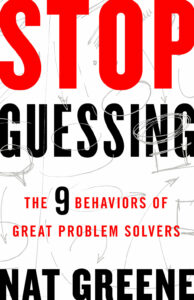Dealing with Problems
We deal with them all day. Whether at work or at home, they seem to chase us down.
What if our problem-solving efforts could be radically improved?
What if you could increase your confidence in solving hard problems?
What if you could stop wasting time and money and implement the right solution?
Serial entrepreneur Nat Greene, author of Stop Guessing: The 9 Behaviors of Great Problem Solvers , says that we are trained to solve easy problems by guessing, and we often only learn to work around problems rather than tackle them.
Great problem-solvers don’t guess. They use different methods and behaviors than most of us. And anyone can learn to improve their problem-solving ability.
The Hidden Costs of Bad Problem Solving
How would you describe the hidden cost of bad problem solving?
Most people understand the basic notion that when problems don’t get solved, value is lost—value to your business and life, and to society. These problems are legion. They affect our health and safety, our happiness. If you think of the toughest problems the world needs to solve, or your business needs to solve, I’m sure you’ll come up with many of them. And you’ll have a very clear understanding that solving these could make a huge difference.
These problems persist simply because we’re not solving them. However, bad problem solving is far more nefarious. Bat problem solving means poor solutions—solutions that are wasteful, painful, or make things even worse than the problem. You may know the proverb, “the medicine is worse than the disease.” Think of examples where a famous business or large government has thrown massive amounts of resources at a problem without a real strategy. Or when a major asset wasn’t working, and instead of solving the root cause of the problem, the organization just bought a new one and hurt its debt position.
Such bad problem solving is worse than the problems themselves for two reasons. First, when a problem is badly solved, people stop trying to come up with a better solution. They may have fooled themselves into thinking they had a good solution or decided the bad solution was “good enough” or even realized that by “solving” the problem, they lost political permission to keep working on it. So unlike an unsolved problem, a bad solution is something you’re likely to be stuck with.
The second issue is that we begin to believe these bad solutions are all that is possible. It’s so common for people to work around an issue, patch it, throw money at it, or learn to live with it, that if we are not vigilant, we will begin to believe this is just a harsh reality we must accept. Through their lives, many people will just lower their expectations about what’s possible. They’ll stop trying so hard to come up with great solutions to the world’s hardest problems because they’ve been taught by example that it can’t be done.
Why are people unable to solve hard problems?
The most basic answer is that nobody taught them how, and actually taught them how to solve easy problems instead. Easy problems have few likely root causes—perhaps 2 or 3—and guessing can be an effective way of quickly getting to the root cause. Say your light bulb is out—the bulb is probably burnt and you should replace it. If that doesn’t work, try the breaker switch. If that doesn’t work… well, maybe you just forgot to flip the switch in the first place. That’s easy stuff, and guessing works just fine.
We’ve learned to guess at problems because it’s worked for us, but it’s also reinforced everywhere. In school, if a teacher asks a question, we’re expected to shoot up our hand with a guess. If we’re wrong, we’re still rewarded—“good try!” In work, when there’s a serious problem, people get together and brainstorm “ideas” (that’s code for “guesses”) about what to do next. In the haste to solve the problem as quickly as possible, there’s such an urge to act that people want ideas they can try out immediately rather than good problem solving. Even our evolution teaches us to guess: we simply lacked the technical skills to reason out what to do about the saber-toothed tiger that jumped out from behind a bush; thinking too hard about it was pruned from our family tree a long time ago.
Such guessing doesn’t work with hard problems because by their nature they have hundreds or thousands of potential root causes. The true root cause of your particular problem is likely to be hidden or obscure, and you simply won’t be able to guess it. Finding the root cause requires rigor and patience. It requires focusing on understanding the problem and the process itself rather than attempting to come up with solutions right away. What works to solve hard problems is essentially the opposite of what solves easy ones.
You share nine behaviors that great problem solvers use. Do most of us struggle more with one than another?
That’s a great question. I think everyone I’ve met is better at some of the behaviors than others, and in different situations we’re tested in different ways. However I think the one I see people struggle with most is embracing their ignorance. I really believe that getting this behavior right unlocks most of the others.
Embracing your ignorance requires a few things in your mind. You have to understand that you don’t know everything you need to know (yet) in order to solve a hard problem. It’s what you don’t know that lies between you and the solution. You also have to get over a fear of looking stupid. This holds a lot of people back from asking critical questions that will help make massive progress on the problem. Organizations have institutional knowledge, belief, assumptions, and myths about every problem. Until someone embraces their ignorance and challenges these notions by asking stupid questions, your team is going to be stuck grappling with its own misconceptions.
Smell the Problem
Let’s dive into an example. I will ask about one that is definitely not intuitive. “Smell the problem,” which your editor also experienced first-hand while reading your book. Talk a little more about this one.
I think this is my favorite behavior, not just because it has a funky name. Smelling the problem means getting intimately familiar with it, using all of your senses. I see a lot of problem solving being done at a desk with a computer, or in a conference room. People will talk about what’s going on and what might be causing it. Smelling the Problem means getting away from the chair and going to the site of the problem. Get in as close to it as you can. Learn about the problem itself—its nature, its pattern, using all of these senses. Make directed observation and get rich data.
There have been a few problems my team has solved in which smelling it led to key breakthroughs. A team working on a food quality problem should definitely be putting this to work. But even in the energy industry, someone on my team used their nose to sniff out that there were probably gasses coming off a process liquid that were not being accounted for in hydraulic calculations.
Smelling the problem is a behavior, not a step, so it’s something you should constantly be doing. As you learn more about the science behind a problem, come back and use that understanding to inform your further observations.
9 Behaviors of Great Problem Solvers
1: Stop guessing.
2: Smell the problem.
3: Embrace your ignorance.
4: Know what problem you’re solving.
5: Dig into the fundamentals.
6: Don’t rely on experts.
7: Believe in a simple solution.
8: Make fact-based decisions.
9: Stay on target.
Don’t Rely on Experts
“Don’t rely on experts” got my attention as well. When should you go to an expert?
I get ribbed for this one quite often. “Aren’t you an expert, Nat?”
I actually think experts are incredibly powerful allies in solving problems. My dad was a metallurgy professor, and his expertise saved a lot of structures from collapsing. When you’re dealing with a hard problem, you’re likely to be dealing with a complex process or system, with complex science behind it.
Let’s say you’re working with an expert that knows a lot about a system you’re trying to fix. If you ask them the right questions, they’ll help you understand how the system works or how part of it works. They can show you where on the system you can make the most effective observations.
However, many people hand the reins over to these experts to solve the problem for them. This is what I mean by “relying.” Instead of taking the responsibility to solve the problem with the expert as an ally, they ask the expert to become the problem solver. However while experts know a lot about their subject, it doesn’t mean they’re great problem solvers. They’re most likely going to guess. It is a guess based on more experience, but it’s not going to help you with a hard problem. And if you put them in a position to justify their expertise by giving you an answer, they’ll probably give you one.
It’s not fair to them and it doesn’t help you. Ally with experts, but don’t rely on them to solve your problems for you.
Power of Simplifying
Share a little about the power of simplifying and how it relates to problem-solving.
 I’ve already pointed out once that hard problems can have hundreds or thousands of possible root causes. I’ve seen a lot of problem-solving approaches in which people have tried to come up with as many of these possible root causes as they can. One valiant effort in a packaging plant got a list of over 200 before starting the arduous process of trying to test them until they found something that stuck.
I’ve already pointed out once that hard problems can have hundreds or thousands of possible root causes. I’ve seen a lot of problem-solving approaches in which people have tried to come up with as many of these possible root causes as they can. One valiant effort in a packaging plant got a list of over 200 before starting the arduous process of trying to test them until they found something that stuck.
A lot of people want to be fully comprehensive or expansive when solving a problem in order to make sure they didn’t miss anything. This is a noble sentiment, but it is bound to get you in trouble if you don’t also know how to simplify. If you’re solving a problem in a complex system, you want to narrow down your scope. Rather than grapple with dozens of subcomponents or thousands of parts, you’ll make much faster progress by eliminating as many of them as possible and as early as possible. By eliminating large swaths of the system to explore, you change the very problem you’re working on to one that is much simpler.
There are many different techniques you can use in order to make a problem even simpler, but the most important thing here is to employ the behavior of actively looking for ways to limit the scope of the problem and system that you’re working on.
For more information, see Stop Guessing: The 9 Behaviors of Great Problem Solvers

